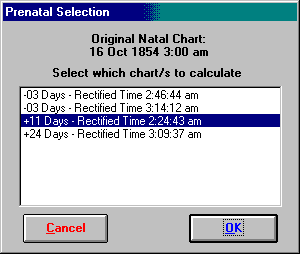Calculation Procedure for Jaynes Prenatal Charts
A starting date is derived by applying the Prenatal Interval, as tabulated in Jaynes Prenatal Charts.
1.If the Chart Inter-relationship involves the sun, then two times are derived by moving forward and backward from the starting date to satisfy the inter-relationship. This results in two starting times that will be one year apart.
2.If there is a Lunar Phase to be satisfied, then further times are derived by moving forward and backward from the starting times produced in previous steps, in order to satisfy these phase requirements. This will produce times that are one lunar month (27.3 days) apart if there is a single lunar phase (such as QM applying), or half a lunar month if there are two possible phases (such as NM or FM separating). This results in twice as many starting times as there were before this step.
3.Each starting time is moved forward and backward until the luminary/angle relationship is satisfied. This results in twice as many starting times as there were before this step.
As a result of these steps, Solar Fire may offer the user up to 8 possible time/date combinations for prenatal chart. It is up to you to choose which one best fits the requirements. Solar Fire indicates how far the charts had to be adjusted to match their starting date and times. The following example shows the choices that Solar Fire offers when calculating a Jayne Mercury prenatal chart. The first number on each line is the deviation from the given prenatal interval. Because this prenatal chart involves matching the position of the Sun with the natal IC, we end up with two groups of possible charts - one between 193 and 178 days later, and one between 172 and 187 days earlier than the given prenatal interval (Step 2). Within each of these groups we have 4 further possibilities, based on the Moon being either new or full, and the time moving either forwards or backwards to be conjunct the Midheaven (i.e. local noon). The second item on each line is how many degrees the moon is away from exactly satisfying the required phase.

For example, the first suggested chart above occurs 193.2 days later than the average prenatal chart of this type, and has a lunar position that is 12.4 degrees away from being either a full or new Moon. Of the visible options, the fourth item (-178.2 Days / -0.8 Degs) would appear to give the overall closest match. However, Jayne suggests that the chart which most closely matches the given prenatal interval or lunar phase is not necessarily the correct chart. Therefore, he recommends that you calculate ALL of the possible charts, and then use your own judgment, as well as rectification and predictive techniques to confirm whether or not each individual possible chart is the valid one. In particular Jayne used directions of longitude of Solar Arc, Ascendant Arc and Vertex Arc, both direct and converse to confirm timing of events. He also directed the declination by each of these arc methods, and used parallels and contra-parallels of declination in timing of events.
Jayne’s conception chart, Uranus (C), is similar to Bailey’s except that the sex of the individual is ignored. The possible conception charts offered by this option are the same as those offered by Bailey’s conception chart if the male and female options were combined. Another difference, however, is that Jayne’s method does not lend itself to allowing a different term of pregnancy to be specified. Instead, Jayne hypothesized that short term births occurred at other prenatal epochs, such as the Morya F or Mars E epochs.
Jayne’s quickening chart, Neptune A, differs more markedly from Bailey’s. Whereas Bailey’s method involves replicating the position of the natal Moon and Ascendant as closely as possible, Jayne’s method involves finding a syzygy between the Moon and the conception Midheaven, and then adjusting the time to give a midnight (Sun on the IC) chart.
Jayne’s birth chart (C) may be used to predict possible birth dates and times based on a natal type chart which has been calculated for the proposed time of conception. However, unlike Bailey, Jayne believes 1) that the true conception chart does not necessarily occur at the time of physical conception, and 2) that the luminary/angle relationship of the chart does not need to be exact. Therefore this method would not be able to predict an accurate birth time. However, this chart calculation method is included in Solar Fire for completeness and to allow experimentation.
A number of other charts in this list require another prenatal chart to have been calculated before they can be used. The list below summarizes which prenatal charts are based on other prenatal charts.
Epoch |
Based on |
|---|---|
Sigma S |
Uranus C |
Jupiter Z |
Morya F |
Rex H |
Uranus C |
Venus R |
Pluto T |
Neptune A |
Uranus C |
Mars E |
Uranus C |
Saturn B |
Uranus C or Natal |
For example, to calculate a Neptune chart, you must first calculate a Uranus chart, and then use that as the base chart for the calculation of the Neptune chart.
